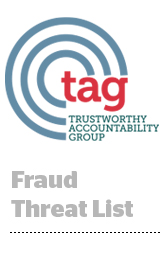 The Trustworthy Accountability Group (TAG), a group created by the IAB, ANA and 4As late last year, have announced the creation of a Fraud Threat List through which members will share URLs they consider fraudulent to create a master blacklist.
The Trustworthy Accountability Group (TAG), a group created by the IAB, ANA and 4As late last year, have announced the creation of a Fraud Threat List through which members will share URLs they consider fraudulent to create a master blacklist.
“We are developing a registration program to create a safe zone for the digital advertising supply chain,” said TAG interim CEO Mike Zaneis.
AOL, Yahoo’s BrightRoll, Facebook’s LiveRail and SpotXchange are piloting the program, which will run for 30 days and focus on video inventory. In the meantime, TAG is calling for public comments.
“We see every day the apprehension to move money to digital because of this issue,” said Jim Norton, global head of media sales for AOL, to explain its participation in the program. “We’re coming off the very successful NewFront. Everyone’s promoting premium. No one is promoting false traffic.”
But wouldn’t ad tech companies want their clean inventory recipe to remain a secret?
“That has been a concern: Are people going to come and share the valuable data?” Zaneis said. “What we’ve found is that the industry realizes this is inhibiting investment from markets, and there is a collective desire to clean it up, so they can compete for a growing slice of the pie.”
Zaneis sees TAG’s Fraud Threat List as an opportunity for companies specializing in anti-fraud solutions. “We view the fraud vendors as vital to success,” he said. “Most of the information comes from companies who already use a fraud service vendor. Everyone participating will have to share information in,” spurring demand to use a vendor to access that information.
Fifty companies, including the pilot companies – all TAG members – belong to the Anti-Fraud Working Group that developed the idea of a fraud threat list over the past couple of months. After TAG incorporates learnings from the pilot program, it expects to see more companies join the group in the third quarter of this year.
Suspect sites will be added to the fraud threat list if multiple platforms notice the same domain acting suspiciously. Blacklisted publishers can appeal via arbitration.
Domain masking could still be an issue, but Zaneis believes that publishers quickly morphing domains will be easier to suss out. “The more you force them to change inventory, the easier it is to find,” he said.
Besides the Fraud Threat List, TAG is working toward a solution to help publishers source traffic, to ensure that fraud doesn’t slip in that way. Paid traffic, often bought at the end of the month to meet page-view requirements, is a common way that fraud slips into higher caliber sites.
TAG also plans to create real-time alerts so partners know if malware infects a campaign. “Malware especially can affect hundreds of thousands of computers in hours,” Zaneis said.
After finding malware, TAG will pass on information to law enforcement via partnerships with the FBI and Secret Service. They can arrest and prosecute purveyors of malware.
But fraud will take approximately $6.3 billion ad dollars in 2015 (according to an ANA/WhiteOps study last year), enough to buy every Super Bowl ad for the next 17 years and more than the combined profits of the ten global advertising agencies.
With bad actors armed with a deep pool of money, cleaning up needs to be a group effort and a priority for publishers, tech companies and agencies. By creating opportunities for everyone in the industry to work together on this issue, TAG hopes to make meaningful process on this issue.
“It’s about having a unified industry solution,” Zaneis said. “We will be stronger if we stand together and take the fight to every step along the chain.”














